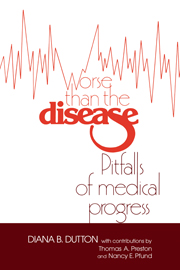2 - Where are we and how did we get there?
Published online by Cambridge University Press: 05 May 2010
Summary
To understand medicine's present predicaments, it is useful to begin with a brief overview of their historical context. The character of medical science has changed dramatically since the turn of the century as a result of increasing public and private investment and expanding scientific capabilities. These changes, in turn, have fundamentally transformed medicine's role in American social and political life. They have created new moral rights on the part of society, and new responsibilities on the part of biomedical science.
There are also countervailing trends. The more esoteric medical advances have become, the more difficult it is for lay citizens and their elected representatives to exercise meaningful influence over policy choices. At the federal level, biomedical and regulatory priorities are increasingly permeated with the government's economic agenda for promoting private technological innovation and development. Opportunities for direct public participation in governmental decisionmaking have been curtailed, and public confidence in traditional forms of representative government has declined sharply in recent decades. Together, these developments lie at the heart of medicine's present dilemmas and represent the central challenge to their resolution.
The nature of modern medical science
Medicine's evolution during this century has altered not only its internal character but also its relation to the larger society. Both types of change have left modern medicine more beholden than ever to the society that supports it and that is affected by its risks and benefits.
- Type
- Chapter
- Information
- Worse than the DiseasePitfalls of Medical Progress, pp. 13 - 28Publisher: Cambridge University PressPrint publication year: 1988



